Shopify Pricing and Plans: Choosing the Right One For Your Scaling Store
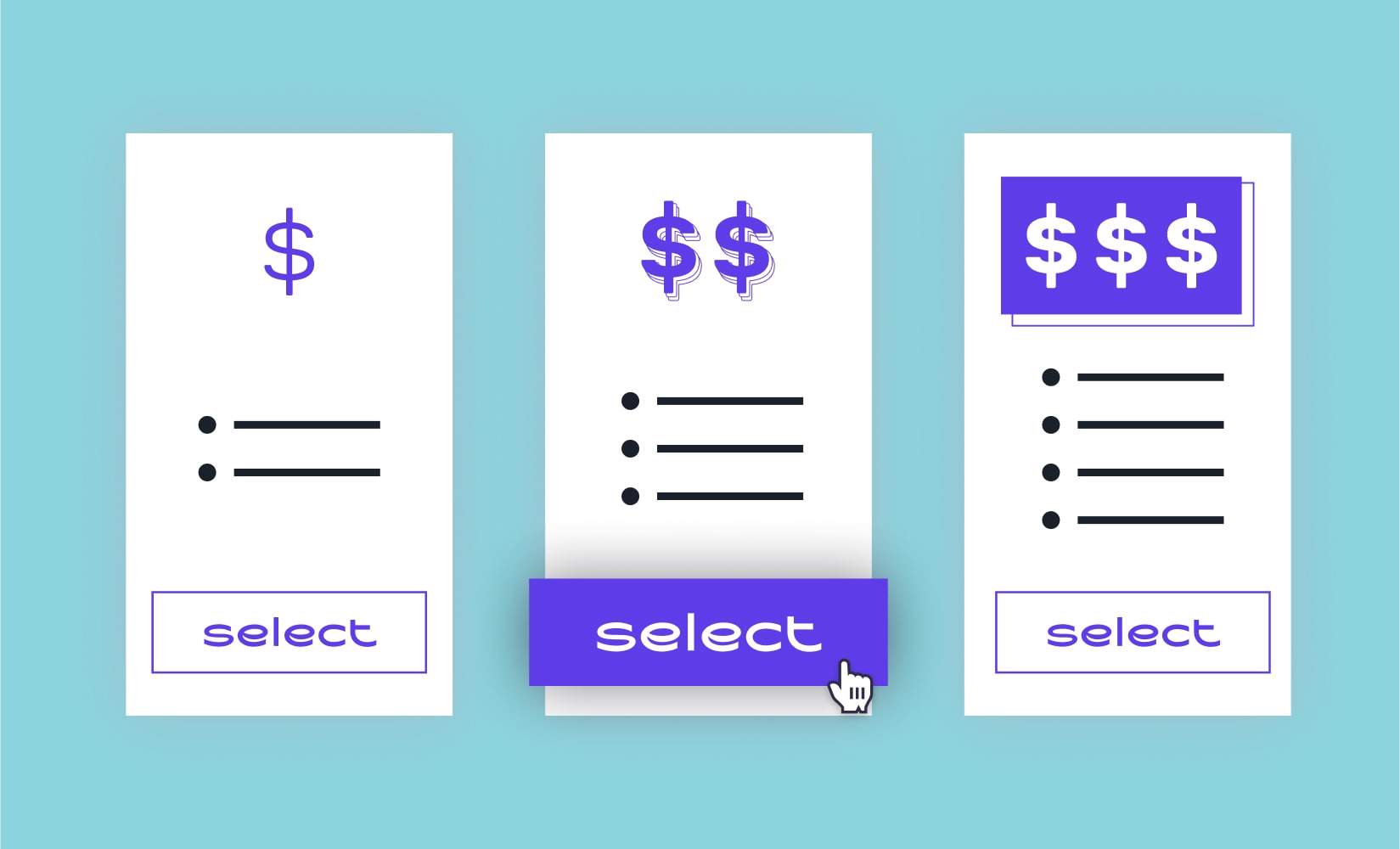
Having your own direct-to-consumer online store gives you more control over your buyer experience, customer relationships, and branding.
However, it can also come with more complex decisions.
For example, selecting the right Shopify pricing plan for your brand depends on where you are in your products’ life cycle, your growth trajectory, and your future audience goals.
In this article, we’ll cover:
- Picking the best Shopify pricing plan
- Shopify selling fees
- Shopify Lite pricing
- Basic Shopify pricing
- Shopify plan pricing
- Advanced Shopify pricing
- Shopify Plus pricing
Let’s start by talking through the factors that will help you choose the right plan for your store as it scales.
Revenue is everything in ecommerce—it determines whether you can expand to new markets, or have to destroy inventory you can no longer afford to warehouse.
Selecting the right Shopify pricing plan ensures:
- You don’t pay too much for features you won’t or can’t use (yet)
- You do get access to features that’ll make running your business more efficient
By finding the right fit, you can leverage (and pay for) the exact Shopify plan and features your brand needs at this stage in your growth.
#cta-visual-pb#<cta-title>Build the perfect Shopify store for your brand<cta-title>Use Shogun Page Builder to seamlessly compose your dream website.Start building for free
Factors to consider when choosing your Shopify pricing
A few big questions to answer when selecting your Shopify plan are:
- What is your average order value (AOV) and number of orders?
- What features do you need?
- What features are unnecessary?
- What features will you need?
What is your AOV and average number of orders?
Stores with more orders per month and a higher AOV will end up paying less with a higher Shopify plan.
On the flip side, stores with fewer orders and smaller cart sizes are likely better off using one of the introductory Shopify plans.
Let’s calculate an example of how this plays out below. Note: This calculator is still using the old pricing, but it still helps to find the right plan.
Store 1 is a smaller store with lower monthly revenue, and fewer transactions.
- Average monthly revenue: $1,500
- Average number of orders per month: 50
- Average cart value: $30
With these numbers, Store 1 would pay $87.50 per month for Shopify Basic and $350 for Shopify Advanced. A clear choice for a small store.
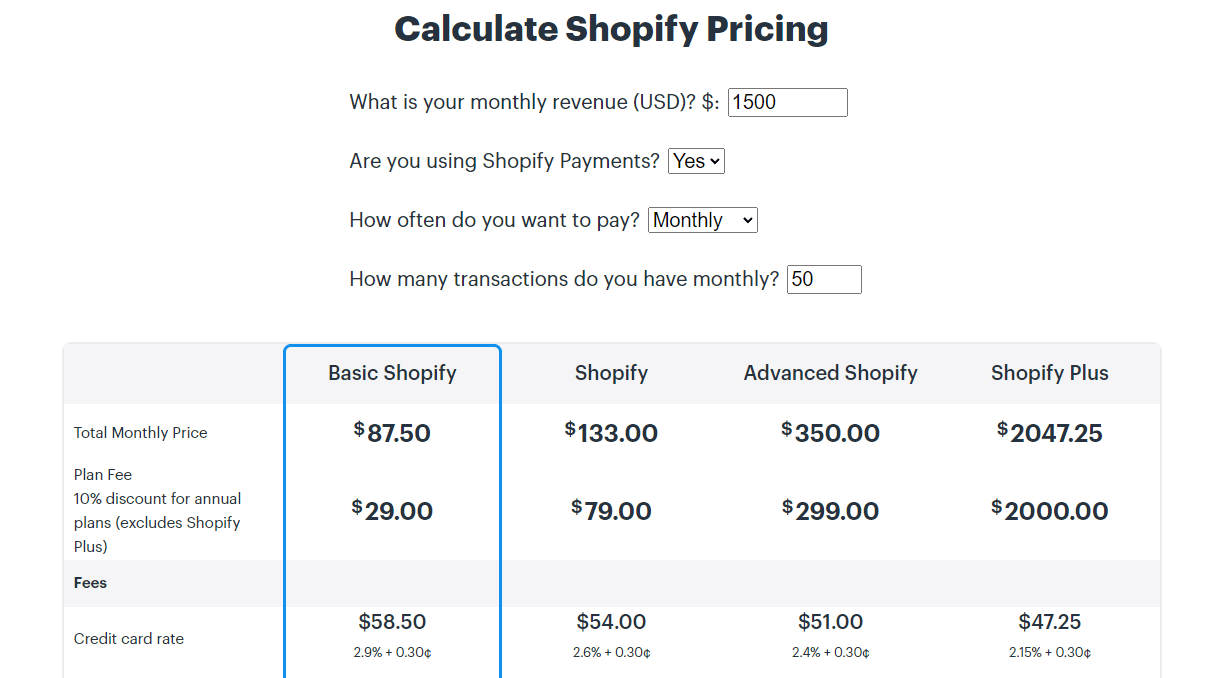
Store 2 is an established store with higher revenue and transaction volumes.
- Average monthly revenue: $150,000
- Average number of orders per month: 2,000
- Average cart value: $75
With those numbers, Store 2 would pay $4,979 for Shopify Basic—even more than they would pay for Shopify Advanced, at $4,499.
So they get more features for a lesser cost, an easy choice.
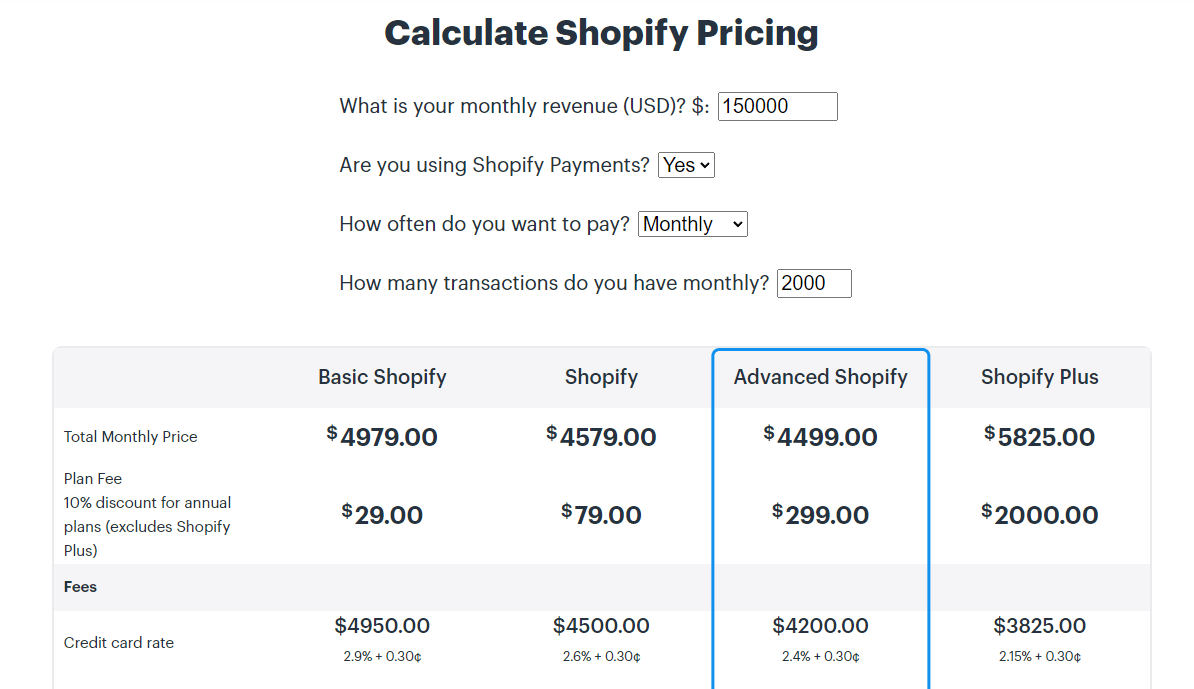
Note that these calculations will look different if you do not use Shopify Payments since Shopify will charge an additional transaction fee.
This transaction fee gets lower with the higher tier plans, which further compounds savings for high-volume stores.
What features do you need?
Look at which plan offers everything you need to operate your store today.
Consider the features you didn’t originally consider but would help you immensely moving forward. Although you could live without them previously, they could be worth the investment as you scale your store.
For example, if you want to grow your team or expand your retail locations, having more staff accounts and additional location support in Shopify will help keep things segmented and organized.
As another example, fraud analysis isn’t as vital if you have a low monthly order volume.
Your team is likely still personally handling each order and can call out if something looks off because of their familiarity with your product and customers.
In the time between when the fraud first occurred and when someone caught it, you may not have sent out any additional orders or suffered many losses.
However, when you’re selling thousands of units daily, automating fraud analysis can help you catch a problem early, saving a lot of money.
When you operate in high volumes, even just an hour lapse can result in thousands of product losses simply due to how quickly everything is moving.
Ask yourself:
- What mission-critical features do I need to run my store?
- What are some features that’d make my teams’ lives easier?
- What are the features that can improve how I sell?
- How big is our team today?
What features are unnecessary?
Bigger doesn’t always mean better. If you’re unprepared, feature-rich plans can often result in bloat and a clunky experience.
For example, if you aren’t sure how to optimize post-purchase upsells, your buyers could see a generic product “recommendation” that doesn’t make sense for their order.
Instead of landing an upsell, you make your buyers wonder, “I just bought a couch, why are they recommending another one?”
Avoid getting distracted by shiny objects, and be realistic about what you won’t use.
Ask yourself:
- Will I or my team use that feature, or will it be forgotten?
- Will that feature require a new process? Is it realistic to expect my team to adopt a new process?
- Does this feature need a “champion” for adoption? Is it worth that person’s time?
- Which features take the lowest priority? Those are often the ones you can cut out.
What features will you need?
Finally, consider your growth trajectory. Look at what your goals are and how fast you’re achieving them.
Even if you don’t need all of a plan’s features today, you may want to make preparations for future growth so your team isn’t caught without the necessary tools to scale.
Likewise, if you see a sunset in your brand or store’s near future, you may want to downgrade your plan to accommodate your existing customers without making concessions for new acquisitions.
Ask yourself:
- Do I plan to expand internationally soon?
- Will I need more inventory locations soon?
- What’s our expected rate of growth over the next quarter? How about over the next year?
- What sales channels will I begin selling on?
Answering all of the above questions should give you a healthy picture of what plan is right for your brand.
Armed with that knowledge, let’s venture into the different Shopify pricing tiers and plans available to merchants today.
Shopify pricing and plans in 2023
As of the time of this writing, Shopify has five plans: Shopify Starter, Shopify Plus, and three tiers under their regular pricing.
All Shopify plans also come with 3-day free trials, so merchants can test different features and get comfortable with their tech stack before the first payment is due.
They also have a deal where you can use the platform for three months at just $1 per month following your free trial period.
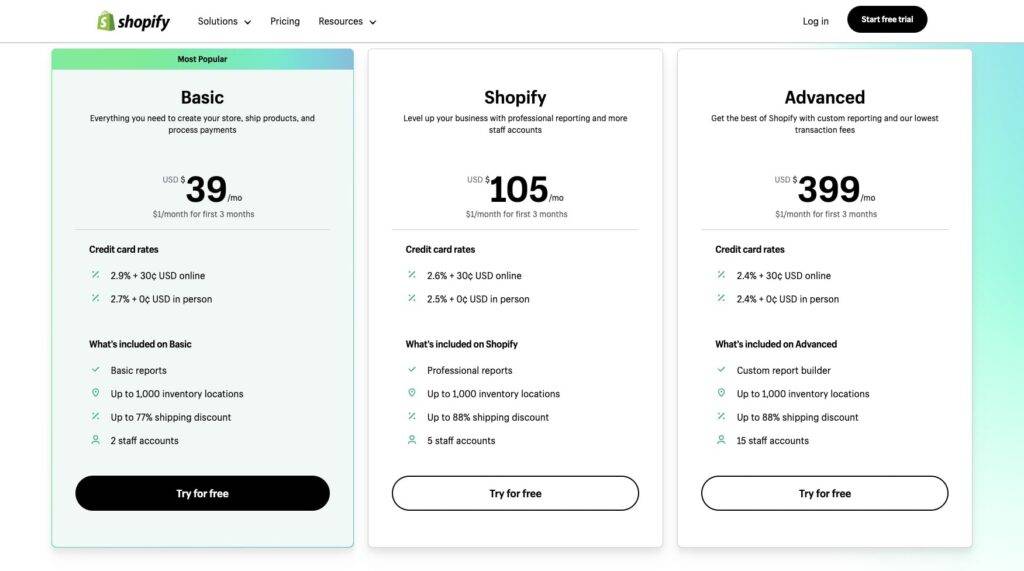
Below is a quick overview of the different plans and features plus their price per month, followed by a more in-depth analysis of each.
Shopify Plan | Monthly Price (USD) | Best For |
Starter | $5 | New ecommerce sellers just getting started. Does not include full online store, but allows for selling through social and messaging apps. |
Basic | $39 | Ecommerce merchants with one or two team members. |
Shopify | $105 | Growing brands that want more visibility for their store. |
Advanced | $399 | Brands with larger teams, more inventory locations, and a growing international presence. |
Plus | $2,000 | Established enterprise brands that want to leverage Shopify’s sophisticated tools and integrations. |
The prices above are the monthly fees for a recurring Shopify subscription.
If you sign up for a one-, two-, or three-year billing cycle, you can receive a discount on your subscription charge.
You might be wondering about more granular charges, like how much Shopify takes per sale in various fees and what other costs you might see along the way.
In addition to the Shopify subscription fees above, there are a few other costs to keep in mind.
Shopify fees (and possible extra costs) include:
- Sales tax: Shopify collects sales taxes in certain states where required by law. The prices above do not include those collections.
- Credit card fee: Shopify charges a fee to accept major credit cards for store payments. This fee varies depending on your plan—between 2.9% and 2.4% and 30¢ per transaction.
- Transaction fee: Shopify charges a fee per transaction when using third-party payment providers. This fee varies depending on your plan—between 2% and 0.15%—and is waived if you use Shopify Payments (Shopify’s payment provider).
- Paid themes: Shopify has a number of free themes to choose from that are well-designed and easy to navigate. However, if you want one of the more sophisticated themes or special designs or functionality, you’ll likely have to pay for it.
- Shopify apps: Some of the best Shopify apps come with their own price tags in addition to your Shopify subscription. Depending on what tech stack you want to use, you should factor in the monthly cost of those premium apps.
- POS payments: If you use Shopify POS in your stores, their in-person credit card rates start at 2.4% and go as high as 2.7% per transaction.
- Shopify card reader: For those using Shopify POS in retail stores, Shopify card readers are required to accept payments and start at $49 USD.
- POS Pro: Shopify plans come with basic POS functions, but you can unlock more with POS Pro, which is $89 per month per POS location on top of their subscription plans*. Some added features include more staff permission settings, faster workflows, and deeper analytics.
*POS Pro is included with Shopify Plus plans.
#cta-visual-pb#<cta-title>Craft a store that drives conversions<cta-title>Test different layouts, features, and plans to discover the best-converting store.Start building for free
The Shopify Starter plan is Shopify’s entry-level subscription that provides all the basics ecommerce merchants need to run their DTC store.
This plan is best for small merchants who are just starting out or sellers who have an existing website and want to add ecommerce functionality (with the Buy Button).
The Shopify Starter plan doesn’t include an online store, but it gives merchants a buy button for online sales and in-person retail capabilities.
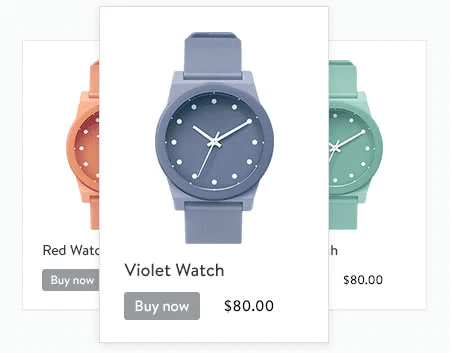
The Shopify Starter plan is a good option to gain easy access to Shopify’s social selling integrations.
For example, you can integrate Shopify with Facebook Shops to expand your sales to Facebook.
It’s also an excellent option for physical retailers with a small existing online footprint.
Combining retail capabilities and online sales via Shopify Lite can help merchants scale their online sales as their business grows, or move more of their operations online.
Features:
- Access to Shopify Admin
- Buy Button and Shopify POS Lite sales channels
- Overview dashboard
- Financial reports
- Customer profiles
- Order management
- Product management
- Mobile POS and hardware accessories
- Email carts
- QR code product details
- In-store inventory
- Gift cards
- Split bills
- Custom discounts and discount codes
- Abandoned cart recovery (available at additional cost)
Shopify Starter pricing
Monthly subscription fee: $5
Transaction fee when using Shopify Payments: Free
Transaction fee for third-party payment processors: 2%
Credit card fees: 2.9% + $0.30 for online transactions
Note that Shopify’s pricing may vary by country. For example, UK credit card fees are 2.2% + 20p per online transaction, and 1.7% for in-person transactions.
The Shopify Basic plan is the first of Shopify’s three main tiered plans (Shopify Basic, Shopify, and Shopify Advanced).
Shopify Basic provides everything a growing merchant needs to establish a strong DTC presence.
Merchants get access to a fully functional online store and website, different Shopify themes to choose from, access to the Shopify app ecosystem, and fraud analysis.
Fraud analysis is important to stay on top of as you scale because while dealing with one or two scammers is a headache—dealing with hundreds is a nightmare.
This is an excellent choice for new brands that want to hit the ground running.
Features:
- Online store with hosting
- Unlimited products
- 24/7 support
- Abandoned cart recovery
- App ecosystem with 4,100+ apps
- Print shipping labels
- Sales channels: Sell on online marketplaces and social media. Channel availability varies by country.
- Fast and reliable checkout
- Free SSL certificate
- Over 100 currencies for your online store
- Discount codes
- Shopify POS Lite: Accept casual, in-person payments at markets, fairs, pop-ups, and more.
- Shopify POS Pro for $89 USD a month for each location
- Manual order creation
- Gift cards
- Up to two staff members
- Up to four locations
- Fraud analysis
Biggest differences from Shopify Starter: Access to an online store, support for multiple team members, additional currency support.
Shopify Basic pricing

Monthly subscription fee: $39, $29 when paying annually
Transaction fee when using Shopify Payments: Free
Transaction fee for third-party payment processors: 2%
Credit card fees: 2.9% + $0.30 for online transactions
Currency conversion fee: 1.5%*
*Applies to U.S. only. Up to 2% elsewhere.
This is the classic Shopify plan, ideal for a growing business or merchants looking to expand across more sales channels.
This plan comes with everything in the Basic Shopify Plan, plus more staff members, more locations, and more advanced reporting.
This is important as you begin to dive into what works, test different marketing and growth strategies, and measure results.
We recommend this plan for brands that are established on other sales channels such as Amazon or Walmart.com and want to expand their own Shopify DTC store.
If you have a robust and active Instagram following and want to venture into selling on Shopify, this is a great place to start.
Features:
- Online store with hosting
- Unlimited products
- 24/7 support
- Abandoned cart recovery
- App ecosystem with 4,100+ apps
- Print shipping labels
- Sales channels: Sell on online marketplaces and social media. Channel availability varies by country.
- Fast and reliable checkout
- Free SSL certificate
- Over 100 currencies for your online store
- Discount codes
- Shopify POS Lite: Accept casual, in-person payments at markets, fairs, pop-ups, and more
- Shopify POS Pro for $89 USD a month for each location
- Manual order creation
- Gift cards
- Up to five staff members
- Up to five locations
- Fraud analysis
- Professional reports
Biggest differences from Shopify Basic: More staff and location support, access to standard reports, lower transaction fees when not using Shopify Payments.
Shopify classic pricing

Monthly subscription fee: $105, $79 when paying annually
Transaction fee when using Shopify Payments: Free
Transaction fee for third-party payment processors: 1%
Credit card fees: 2.6% + $0.30 for online transactions
Currency conversion fee: 1.5%
The key differentiators for the Advanced Shopify plan are access to third-party calculated shipping rates at checkout and more support for international markets.
For example, this plan can provide cost estimates and collect duties and taxes at checkout to provide cost clarity for buyers in any country.
Merchants can also set different prices depending on the market, so you can show one set of prices to local shoppers (where shipping might be more affordable), and another to international shoppers (where it may be more costly to send them the items).
This plan is a good pick for merchants who want access to more advanced features to scale their businesses, grow into global markets, and expand their teams.
Features:
- Online store with hosting
- Unlimited products
- 24/7 support
- Abandoned cart recovery
- App ecosystem with 4,100+ apps
- Print shipping labels
- Sales channels: Sell on online marketplaces and social media. Channel availability varies by country.
- Fast and reliable checkout
- Free SSL certificate
- Over 100 currencies for your online store
- Discount codes
- Shopify POS Lite: Accept casual, in-person payments at markets, fairs, pop-ups, and more
- Shopify POS Pro for $89 USD a month for each location
- Manual order creation
- Gift cards
- Up to 15 staff members
- Up to eight locations
- Fraud analysis
- Professional reports
- Advanced report builder
- International pricing
- Duties and import taxes
Biggest differences from Shopify: More staff and location support, access to advanced reports, lower transaction fees when not using Shopify Payments, more international sales support such as duties and tax collection and custom pricing based on market.
Shopify Advanced pricing
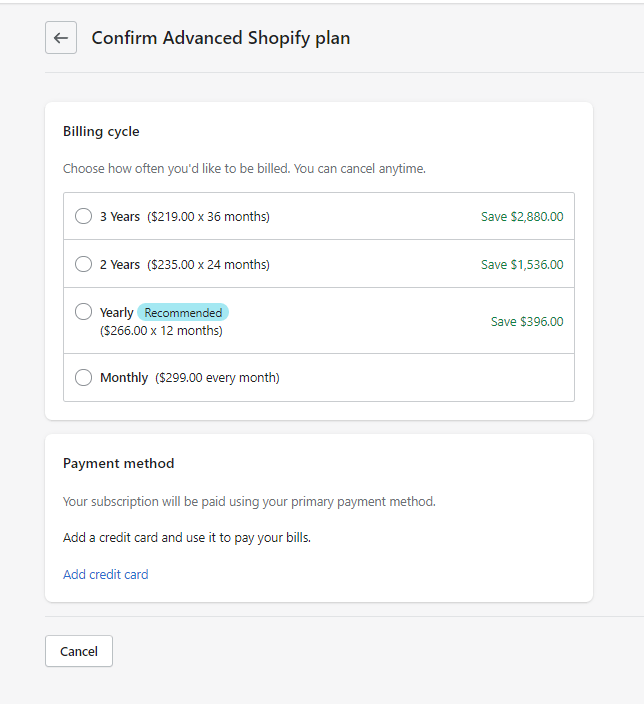
Monthly subscription fee: $399, $299 when paying annually
Transaction fee when using Shopify Payments: Free
Transaction fee for third-party payment processors: 0.5%
Credit card fees: 2.4% + $0.30 for online transactions
Currency conversion fee: 1.5%
Transaction fee for duties and import taxes: 1.5%, or 0.85% for Shopify Payments
Finally, let’s talk about Shopify Plus.
Shopify Plus pulls out all the stops to give large enterprise merchants the tools and services they need to propel further success. It includes the core services of the Shopify plans, plus additional features to facilitate high-volume sales.
Shopify Plus is designed for enterprise merchants, with more tools like additional apps and integrations, more API calls, automated workflows, and multi-currency selling with IP detection.
If you have a large brand and budget, this plan will give you access to Shopify’s most sophisticated tools and your very own launch team to get your store up and running.
Features:
- A Launch Team to help get your store online faster and resolve any migration or technical issues
- Access to the Shopify organization admin to manage your stores from a single central hub
- Fully customizable checkout process
- Advanced Shopify apps for high-growth merchants
- Additional API calls to integrate with custom tools
- Access to the Shopify Plus Academy for self-guided merchant training
- Add up to 100 themes to your Shopify account
- More sophisticated permission controls
- Ability to add a password-protected wholesale channel
- Unlimited staff
- Up to 20 inventory locations
- Shopify POS Pro for every location at no additional charge
Biggest differences from Shopify Advanced: Built-in augmented reality, video, and 3D media on product pages, more sophisticated API access, smart automation workflows, tax automation.
Shopify Plus pricing
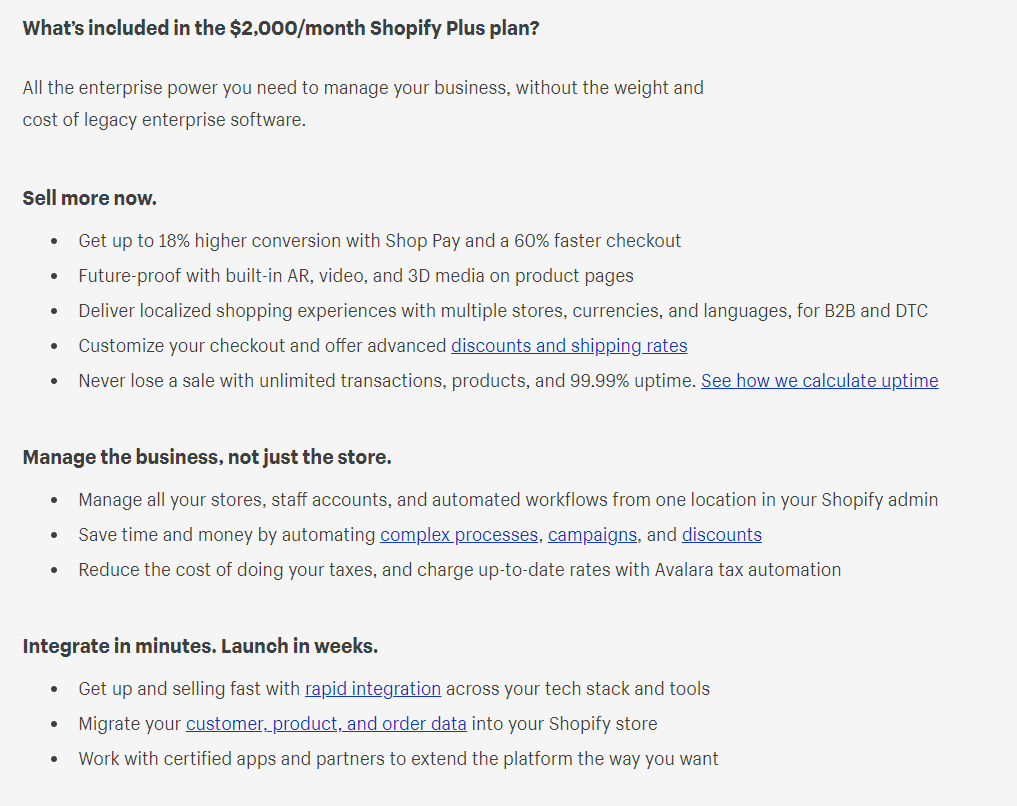
Monthly subscription fee: Flexible, starting at $2,000. Potential to negotiate a percentage of sales.
Variable fee: A negotiable fee based on the complexity of your setup
Transaction fee for third-party payment processors: 0.15%
Find just the right Shopify plan for your growing store
Choosing the right Shopify plan and pricing for your brand can seem daunting. It’s difficult to know what you do and don’t need at first glance.
However, the questions and suggestions in this article should point you in the right direction.
If you have your own website and want to turn on ecommerce features, Shopify Starter can give you access to basic online selling tools.
If you’re just getting started and want to launch your DTC store, the Basic Shopify plan provides an entry-level suite of tools.
If you’re a growing business and want to enhance your brand experience, the Shopify plan supports larger teams and more inventory locations.
If you’re an established seller, have a recognizable brand, sell on multiple platforms, have a team behind you, and want to sell globally, the Advanced Shopify plan unlocks more features and markets.
Finally, if you’re an enterprise brand that wants the best-in-class tools to scale your brand and craft custom experiences, Shopify Plus comes with even more apps, integrations, and support.
Consider your current wants and needs as well as your growth trajectory and where your brand will be in the coming years when making your choice.
#cta-visual-pb#<cta-title>Picked a plan? Build a website to go with it<cta-title>Utilize the full power of your Shopify plan.Start building for free
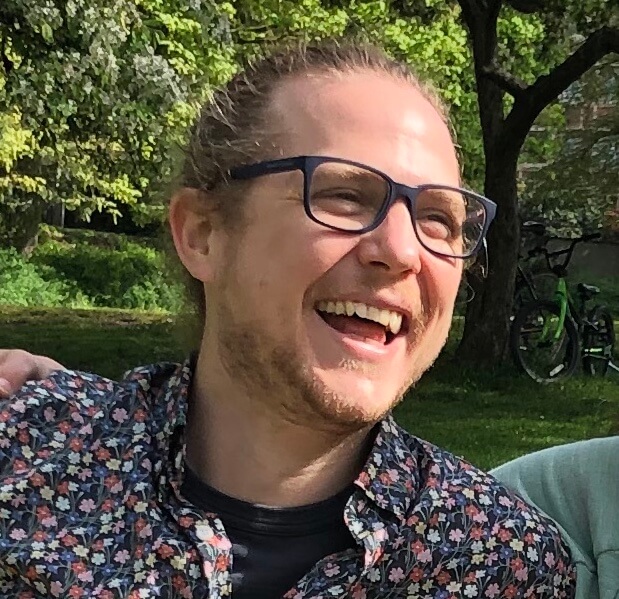
Sean Flannigan
Sean is one of Shogun's tireless content marketers. When he isn't creating exciting ecommerce content, he's probably biking or at the park.



